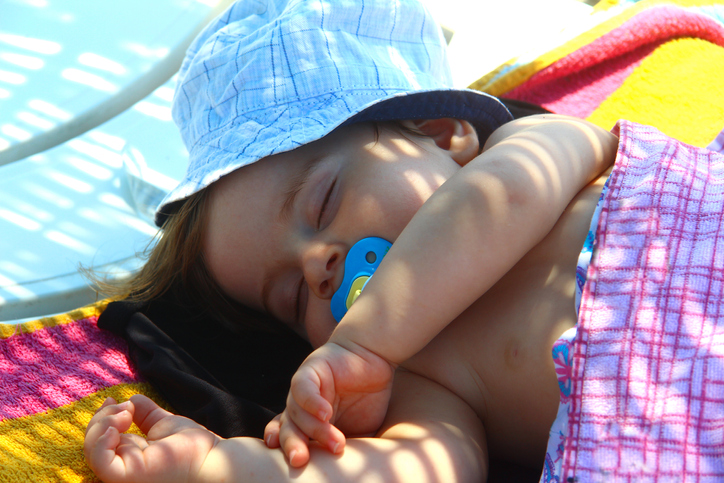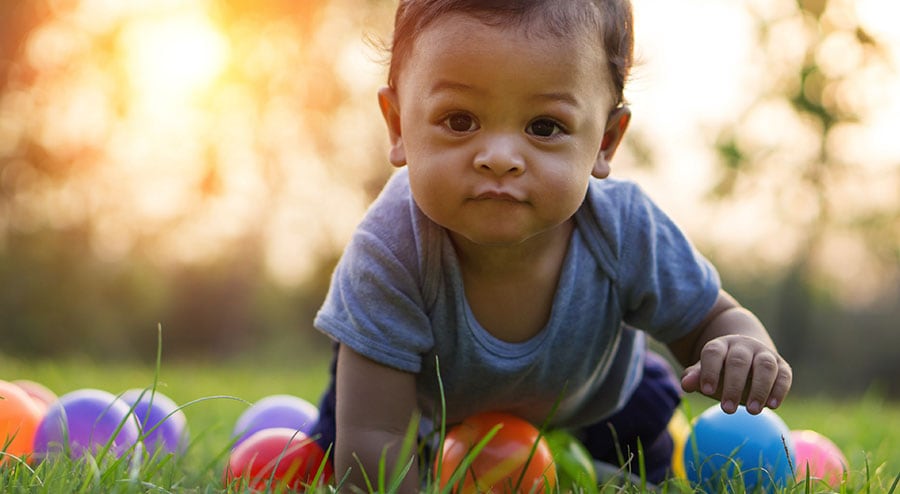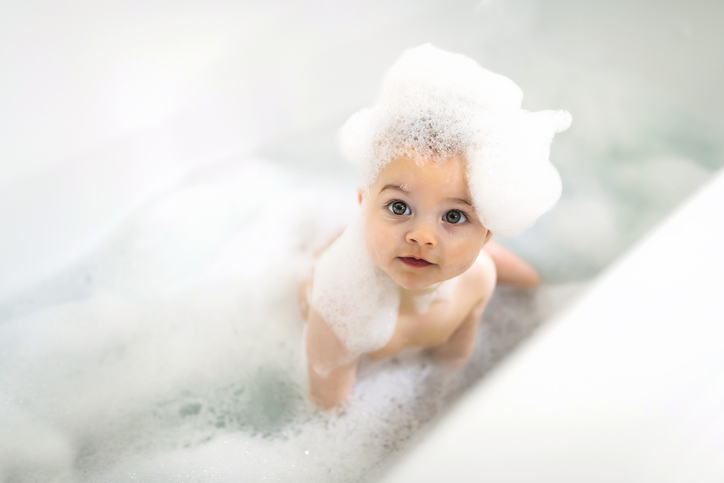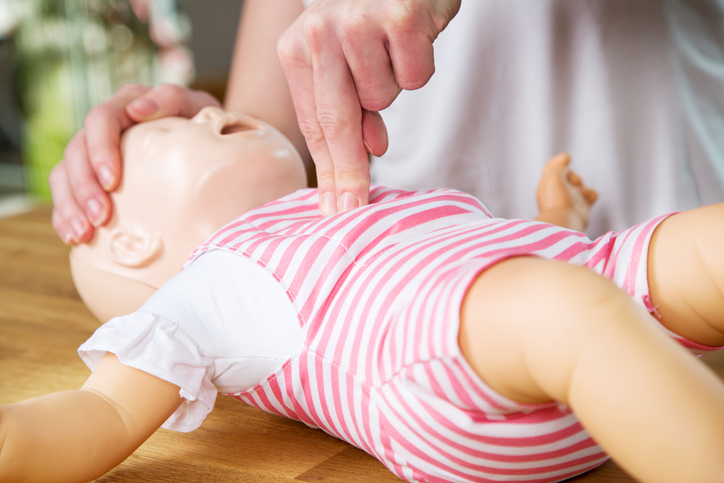Babies have incredibly delicate skin that requires special attention and care, especially when it comes to sun exposure. Protecting infants from sunburn is of utmost importance as their young skin is more vulnerable to the harmful effects of UV rays. Let us explore the best practices and products that can help keep those precious little ones safe from the harmful effects of the sun.

The Risks of Sun Exposure for Infants
Understanding the risks and consequences of sun exposure for infants allows parents to make informed decisions and take the necessary steps to ensure their baby’s well-being under the sun.
Table of Contents
- The Risks of Sun Exposure for Infants
- Sunscreen for Infants: When and How to Use It
- Dressing Your Baby for Sun Safety
- Time and Location: Sun Safety Considerations
- Sun Protection on the Go: Traveling with Infants
- Handling Sunburn in Infants: Signs, Treatment, and Prevention
- Alternatives to Chemical Sunscreens for Infants
- Conclusion
Baby’s Unique Vulnerability to UV Rays
Babies possess highly sensitive and delicate skin, making them particularly susceptible to the harmful effects of ultraviolet (UV) rays from the sun. Unlike adult skin, a baby’s skin has not fully developed its natural defense mechanisms against UV damage. Their skin contains less melanin, which is the pigment responsible for providing some natural protection against UV radiation. As a result, infants are more prone to sunburn and can suffer from it much more quickly and severely than adults.
The lack of melanin also means that the skin’s ability to repair itself from sunburn is limited in babies. Additionally, prolonged or repeated sun exposure during infancy can have a cumulative effect on their skin, increasing the risk of developing skin cancer later in life. Therefore, it is crucial to shield babies from excessive sun exposure and take preventive measures to keep their delicate skin safe.
The Potential Long-Term Effects of Sunburn during Infancy
The impact of sunburn during infancy extends beyond immediate discomfort. Research has shown that severe sunburn during childhood significantly elevates the risk of skin cancer in adulthood. The damage caused by UV rays during these early stages can lead to genetic mutations in skin cells, paving the way for the development of skin cancers like melanoma later in life.
Taking sunburn prevention seriously from an early age can help reduce the chances of these long-term consequences. We can potentially prevent the development of skin cancer in their adult years, by protecting infants from harmful UV rays.
The Importance of taking Preventive Measures
Given the unique vulnerability of a baby’s skin to sunburn and the potential long-term effects of UV exposure, taking proactive preventive measures becomes paramount. Parents and caregivers must be diligent in providing adequate sun protection for their infants, especially during peak sun hours when UV rays are strongest.
To safeguard their baby’s skin, it’s crucial to create a sun-safe environment by seeking shade and minimizing direct sun exposure. Dressing infants in protective clothing, such as lightweight, long-sleeved outfits and wide-brimmed hats, can provide an extra layer of defense. Additionally, when babies are old enough to use sunscreen (usually around six months), applying a baby-specific sunscreen with broad-spectrum protection and high SPF is essential for shieldng their skin from UV rays.
Protecting infants from sunburn is crucial for their delicate skin, and parents should prioritize sun safety by using sunscreen, dressing them in protective clothing, and seeking shade to minimize the risk of long-term UV damage and ensure their well-being.
Sunscreen for Infants: When and How to Use It
Applying sunscreen is an essential aspect of protecting infants from sunburn, but it’s crucial to use it at the right age. Pediatricians generally recommend waiting until babies are at least six months old before introducing sunscreen to their delicate skin. Before this age, infants’ skin is still developing, and their ability to metabolize and process the chemicals in sunscreen may be limited.
Differences between Adult and Baby Sunscreens
When it comes to choosing sunscreen for babies, it’s essential to opt for products specifically designed for their sensitive skin. Baby sunscreens often contain physical blockers like zinc oxide or titanium dioxide, which sit on the skin’s surface, reflecting and scattering UV rays. These ingredients are less likely to cause skin irritation compared to some chemical filters found in adult sunscreens.
Additionally, baby sunscreens are often fragrance-free, hypoallergenic, and formulated without potential irritants. This reduces the risk of adverse reactions, making them safer for delicate baby skin.
How to choose the Right Sunscreen for your Baby’s Sensitive Skin
Selecting the appropriate sunscreen for your baby requires careful consideration. Look for brands that clearly state “baby” or “infant” on the label to ensure it is specifically formulated for their needs. Choose a sunscreen with broad-spectrum protection, guarding against both UVA and UVB rays, and opt for an SPF of 30 or higher.
For babies with sensitive skin, it’s best to avoid sunscreens with added fragrances, parabens, and phthalates. Instead, look for hypoallergenic and dermatologist-tested options to reduce the risk of skin irritation. Brands like “CeraVe Baby Sunscreen Lotion” and “Aveeno Baby Continuous Protection Sensitive Skin Zinc Oxide Sunscreen” are highly regarded for their gentle formulas, offering broad-spectrum protection with SPF 50.
Sunscreen Application and Reapplication for Infants
Once you’ve chosen the right sunscreen for your baby, proper application and reapplication are key to maintaining sun protection. Apply sunscreen generously to all exposed areas of the skin, ensuring there are no gaps in coverage. Pay particular attention to the face, ears, hands, and feet.
For infants, it’s advisable to reapply sunscreen every two hours or more frequently if they are in the water or sweating. Water-resistant sunscreens can offer some additional protection, but it’s essential to reapply after any water-based activities.
Dressing Your Baby for Sun Safety
Parents can create a comfortable and safe environment for their baby by dressing them in appropriate sun-protective clothing, sun hats, and sunglasses, for them to enjoy outdoor activities without compromising on sun safety
Types of Clothing that Offer the Best Sun Protection for Infants
Choosing the right clothing for your baby is a crucial step in protecting their delicate skin from the sun’s harmful rays. Opt for loose-fitting, long-sleeved outfits that cover their arms and legs. Clothing with a tight weave provides better sun protection, so consider options made from tightly-woven fabrics like cotton or UPF (ultraviolet protection factor) clothing designed explicitly for sun protection.
Brands like “Coolibar” and “i play. by green sprouts” offer a range of sun-protective clothing for infants, including sunsuits, swimwear, and shirts with built-in UPF. For example, the “Coolibar UPF 50+ Baby Wave One-Piece Swimsuit” offers full-body coverage and provides UPF 50+ sun protection, blocking 98% of UVA and UVB rays. This swimsuit is priced at around $40.
Sun Hats and Sunglasses for Eye Protection
Sun hats and sunglasses are essential accessories to shield your baby’s sensitive eyes and face from the sun. Look for wide-brimmed hats that provide ample shade coverage for the face, neck, and ears. Hats with a UPF rating offer additional sun protection. Adjustable chin straps can help keep the hat in place, even on windy days.
“Sunny Buns” and “RuffleButts” are well-known brands that offer baby sun hats with UPF protection. The “Sunny Buns UPF 50+ Wide Brim Baby Sun Hat” features a broad brim, a UPF 50+ rating, and is made from lightweight and breathable fabric. This hat is priced at around $20.
When it comes to sunglasses for infants, choose styles specifically designed for their small faces and with 100% UVA and UVB protection. “Baby Banz” is a reputable brand that offers baby sunglasses with shatter-resistant lenses and adjustable straps to ensure a secure fit. The “Baby Banz Adventure Baby Sunglasses” typically cost around $15.
Lightweight and Breathable Fabrics for Infant Comfort
While ensuring adequate sun protection, it’s equally essential to keep your baby comfortable in warm weather. Opt for lightweight and breathable fabrics like cotton, as they allow air circulation and prevent overheating. Loose-fitting clothing can also help in keeping your baby cool and comfortable during outdoor activities.
Avoid dark-colored clothing, as they can absorb more heat. Instead, choose light-colored outfits that reflect the sun’s rays. Lighter shades can help regulate body temperature and reduce the risk of heat-related issues.
Time and Location: Sun Safety Considerations
To minimize sun exposure and reduce the risk of sunburn, it’s advisable to plan outdoor activities during safer times of the day. Early mornings and late afternoons are generally the best times to venture outside with your baby. During these periods, the sun’s rays are less intense compared to the peak hours between 10 am and 4 pm when UV radiation is strongest.
Opting for outdoor excursions during the cooler parts of the day, means you can still enjoy quality time with your baby while significantly reducing the chances of sunburn and heat-related discomfort.
Techniques to Keep Infants Cool during Outdoor Activities
When spending time outdoors with your baby, strategic use of shade is essential. Seek out shady spots under trees, canopies, or umbrellas to provide a safe retreat from direct sunlight. If you’re at the beach or a park, consider using a pop-up sun shelter or a beach tent designed for UV protection to create a shaded play area.
Additionally, you can use stroller canopies and baby carriers with sunshades as convenient mobile shade options while on the move. Be mindful of keeping your baby well-ventilated to prevent overheating, and dress them in breathable, lightweight clothing for added comfort.
Indoor Activities for Extremely Hot and Sunny Days
On exceptionally hot and sunny days, indoor activities are a practical and safe option for keeping your baby cool and protected from excessive sun exposure. Consider exploring indoor play areas, children’s museums, or libraries, where your baby can have fun while staying in a climate-controlled environment.
If you prefer to stay at home, create a sun-safe space by closing curtains and blinds to minimize UV exposure from windows. Use fans or air conditioning to maintain a comfortable indoor temperature, and engage in gentle indoor activities like reading, playing with toys, or doing art projects with your baby.
Sun Protection on the Go: Traveling with Infants
When traveling with infants to sunny destinations, it’s essential to prioritize sun protection to ensure a safe and enjoyable experience for your little one. Begin by packing all the sun safety essentials, including sunscreen, sun hats, sunglasses, and sun-protective clothing. Check the UV index for your destination and plan outdoor activities during the safer hours of the day, usually early mornings and late afternoons.
If you’ll be spending time at the beach or pool, consider using a pop-up sun shelter or a beach tent with UV protection to create a shaded play area. Ensure your baby stays hydrated by offering frequent breaks for fluids and staying in the shade during peak sun hours.
Altitude and Sun Protection
When traveling to higher altitudes, such as mountainous regions, it’s essential to be aware that the risk of sunburn increases. At higher elevations, the atmosphere is thinner, and there is less natural protection from UV rays. This means that UV radiation is more intense, and babies are at a higher risk of sunburn and skin damage.
To counter the heightened sun exposure, increase the use of sun protection measures. Use a higher SPF sunscreen on your baby’s skin and reapply it more frequently. Ensure your baby wears protective clothing, including long sleeves, hats, and sunglasses with UV protection, to shield their skin and eyes from the intense sunlight at higher altitudes.
Sun Exposure through Windows in Homes and Cars
Even when you’re indoors, sun exposure through windows can still pose a risk to your baby’s skin. UV rays can penetrate through glass, potentially causing sunburn. To minimize this risk, keep curtains or blinds closed during peak sun hours, especially if the sun’s rays directly shine through the windows.
For car travel, consider using sunshades on the car windows to reduce UV exposure to your baby while driving. These shades can help create a shaded environment within the car, protecting your baby’s skin from direct sunlight.
Implementing sun safety measures not only protects their delicate skin but also allows you to create wonderful memories during your family outings and vacations.
Handling Sunburn in Infants: Signs, Treatment, and Prevention
Signs of sunburn in babies include red, swollen skin that feels warm to the touch. In some cases, blisters may also appear. If you suspect your baby has sunburn, promptly move them to a shaded area or indoors to avoid further sun exposure.
To alleviate the discomfort, give your baby a cool bath or apply a cool, damp cloth to the affected areas. Avoid using any harsh soaps or scrubbing the skin, as this can worsen irritation. Keep your baby well-hydrated by offering fluids regularly, and dress them in loose, breathable clothing to avoid friction on the sunburned skin.
Tips for Treating Sunburned Baby Skin Gently and Effectively
When treating sunburned baby skin, it’s essential to be gentle to avoid causing additional discomfort. Avoid using any products that contain alcohol, as they can further dry out the skin and exacerbate irritation. Instead, opt for a gentle, fragrance-free moisturizer to keep the skin hydrated and promote healing.
One effective option is the “Aveeno Baby Eczema Therapy Moisturizing Cream,” which is suitable for sensitive skin and helps soothe dry, itchy, and sunburned skin. A 7.3-ounce tube of this cream typically costs around $10.
If your baby’s sunburn is severe, causing blisters or intense pain, it’s best to seek medical advice from a pediatrician. They can assess the extent of the sunburn and provide appropriate medical care if necessary.
Preventive Measures to Avoid Future Sunburns
Prevention is key when it comes to protecting infants from sunburn and potential long-term consequences. Emphasize the importance of using sun safety measures, such as seeking shade, dressing babies in sun-protective clothing, and applying sunscreen when appropriate.
Encourage parents and caregivers to plan outdoor activities during safer times of the day and to be mindful of the baby’s comfort and well-being during sunny days. Parents can ensure their baby enjoys outdoor experiences safely and without the discomfort of sunburn, by taking proactive steps to prevent sunburn.
Alternatives to Chemical Sunscreens for Infants
For parents who prefer natural and organic alternatives to chemical sunscreens, there are several options available that can provide effective sun protection for baby’s sensitive skin. Mineral-based sunscreens, also known as physical sunscreens, are a popular natural alternative to chemical sunscreen. These sunscreens use natural ingredients like zinc oxide and titanium dioxide to create a protective barrier on the skin’s surface, reflecting and scattering harmful UV rays.
One reputable brand that offers mineral-based baby sunscreens is “Badger Balm.” Their “Badger Baby Sunscreen Cream” is a certified organic sunscreen that contains natural ingredients, such as zinc oxide, to provide broad-spectrum protection. This fragrance-free and hypoallergenic sunscreen is suitable for babies with sensitive skin and offers peace of mind for parents who prefer a more natural approach to sun protection. A 2.9-ounce tube of “Badger Baby Sunscreen Cream” typically costs around $15.
Effectiveness and Safety of Natural Sunscreens for Baby Skin
Mineral-based sunscreens have been deemed safe and effective for use on baby skin by dermatologists and pediatricians. Since they work by sitting on the skin’s surface rather than being absorbed, the risk of skin irritation is reduced, making them ideal for babies with sensitive skin. Natural sunscreens are also less likely to cause allergic reactions compared to some chemical sunscreens.
However, it’s important to note that mineral-based sunscreens may leave a slight white cast on the skin due to the physical blockers. While this is purely cosmetic and doesn’t impact the sunscreen’s effectiveness, some parents may prefer to blend the sunscreen thoroughly to minimize the white residue.
Conclusion
Protecting babies from sunburn is of paramount importance due to their unique vulnerability to harmful UV rays. Infants’ delicate skin lacks the natural defenses that adults have, making them more susceptible to sunburn and long-term UV damage. Sunburn during infancy can have lasting consequences, including an increased risk of skin cancer later in life. Hence, safeguarding babies from excessive sun exposure is essential for their overall health and well-being. As parents and caregivers, it is our responsibility to prioritize sun protection for our babies. Emphasize the use of sunscreens, protective clothing, and shade to minimize the risk of sunburn and other sun-related issues. By adopting these practices early on, we instill in our babies a healthy sun protection habit that will serve them well throughout their lives.




